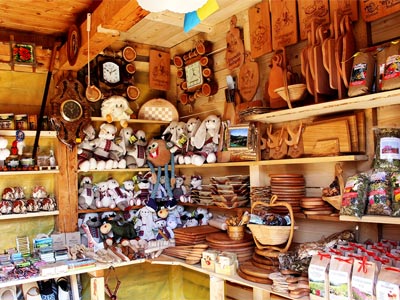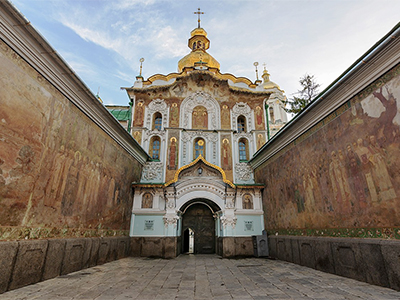 30.01.2023
Ukrainian crafts and souvenirs
30.01.2023
Ukrainian crafts and souvenirsUkraine has very well-developed, sophisticated forms of folk art, some of which date back to antiquity. During prehistoric times, religious beliefs and natural events determined symbols, motifs and colors. Over time, designs were influenced by contacts with foreign cultures and civilization. Byzantium and the Far East left their mark on indigenous art forms as well as Western styles such as Gothic, Renaissance, and baroque.
There is a similarity of basic patterns among the different media, whether pysanky or tapestry. Intricate geometric patterns were the earliest to develop and are still the most common today. Plant and animal motifs developed later out of the geometric forms. Colors and patterns differ according to region. For example, in eastern Ukraine black and red are the predominant colors, but blue and white are also common. Green is favored in certain western areas.
Ukraine has always valued its folk art. Throughout the country, Apterous ethnological museums display folk art collections of breathtaking beauty. Crafts makers attend tekhnikums of folk handicrafts, and designers go to schools of applied art.
Handcrafted items are sold everywhere — art salons, gift and souvenir shops, department stores, museum shops, kiosks, and on city sidewalks. You’ll also find plenty of the usual touristy plastic knick-knacks and tee shirts for sale. These are the major Ukrainian folk arts:
Embroidery
Embroidery, the most popular Ukrainian folk art, with a variety and complexity of stitches, wealth of colors, and intricacy of designs. In traditional culture all household linens and item of folk dress, both female and male, were elaborately embroidered. There were special patterns for special occasions. Today virtually every family has an expert embroiderer. The most common embroidered items are towels, blouses and shirts. The towels are used for accenting furniture or — stitched with religious motifs — as the cover for the ritual basket of food taken to church for the Easter blessing. The sign of skilled embroidery is a reverse side as neat and finished as the front.
Weaving
Weaving had developed into a cottage industry] by the 14th century. Weavers produced various articles of folk dress, towels, tablecloths, kylyms, and bed coverings from flax, hemp, or woolen thread.
Especially important is the kylym, an ornamental woven floor or wall covering. Folk carpet-making dates back to antiquity, but the opening of large mills in the 18th century made kylym production widespread. The basic designs of geometric and plant motifs show some oriental and southern European influence; over time individual weavers developed their own styles, composition, and harmonized coloration. In homes throughout Ukraine, walls are frequently covered with kylyms, but rarely are they used as floor coverings.
Rushnyky
Rushnyky are towels, about 3 to 8 inches wide and 3 to 12 feet long, with geometric or floral patterns primarily near the ends. Traditionally, the rushnyk was used in various folk rituals and religious celebrations. It played a role in every milestone of human life, from birth to death. You can find rushnyky hanging on walls in many homes, particularly in rural areas, where they’re draped over icons or favorite paintings. Highly embroidered ones are used in wedding ceremonies.
Factories throughout Ukraine produce both kylyms and rushnyky.
Pottery
Pottery production is widespread in j Ukraine because of the large deposits of various clays, particularly kaolin (china clay). The ceramic arts date back to prehistoric times. The elegant forms and polychrome designs of the clay artifacts of the Trypilian culture (5,000 To 4,000 B.C.) indicate a high level of sophistication in the process of clay preparation, firing, and decoration. Later ceramics showed complicated geometric designs and were formed in the figures of birds and animals. The introduction of the potter’s wheel after the Mongol period changed the craft. With the development of the stove in the 18th century, all ceramic-producing centers in Ukraine began to produce enameled tiles. Today ceramic centers turn out much functional ceramic ware pitchers, plates, candle holders, and tiles, and, also sometomamental sculpture and toys.
Pysanky
Pysanky, Easter eggs colored with intricate traditional symbolic designs, are perhaps the most widely known items of Ukrainian culture. The name pysanky comes from the verb pysaty, meaning “to write,” because the designs are written on the shell of a whole raw egg with melted beeswax. A batik technique is used: the egg is dipped in a series of dye baths, ranging from the lightest color to the darkest, with wax designs applied by means of a fine pointed stylus following each bath. After hours of work, the wax is removed from the completed egg.
Pysanky date back to prehistoric times. Then, the eggs had a ritual significance. The yolk represented the sun, a pagan god. The eggs were believed to possess magic power to protect against evil, thunder, or fire. In Christian times, the eggs also became objects of good fortune that could bring luck, wealth, health, fertility, good harvest, and protection from harm. As soon as the cock crowed on Ash Wednesday, women and girls rushed to the bams to collect the eggs. They then spent the 40 days of Lent creating the designs. On Easter morning they brought the pysanky to the church, along with some ritual food, for the blessing, but these special eggs were not for eating. The best became gifts and often served as a not-so-subtle invitation to courtship.
Authentic pysanky use traditional symbols which have evolved over millennia. Earliest designs were sun motifs. The meander or endless line representing eternity comes from the Neolithic era. It represents eternity. With Christianity came crosses and miniature churches combined with decorative geometrical designs. Animal motifs originated much later. Colors also have meaning. Each region, even village, had its designs and pigments.
❤️Looking for an English speaking guide on your trip to Ukraine? – Count on us!
The symbols, designs, and colors used in pysanky are repeated in other forms of Ukrainian art. In gift shops you’ll find a variety of wood-crafted pysanky — lacquered, carved, or inlaid — and with luck you may even find some real ones.
Woodcarving
Woodcarving. Ukrainian wood sculpture developed along with church architecture, resulting in elaborate iconostases, lecterns, and columns.
At the same time, the common, people began decorating the interior and exterior of their home with, carved and ornamented details. The Hutsul region in western Ukraine, with, its forest resources, is the major woodcarving center in Ukraine. Hutsul work, is characterized by geometric designs ornamented with inlays of colored wood, hone, mother-of-pearl, beads and metal work. Carved boxes —both rectangular and circular and plates are the most popular examples.
Candle-holders, spoon racks, pipes, and the bulava, or hetman’s mace, are also typical Hutsul woodcrafts. When pricing inlaid woodcrafts, notice how much of the ornamentation, is actually inlaid compared to what is merely painted on the wood. Lemkos, an ethnic group along, the border, are noted for their woodcarvings of animal figures. North of Kyiv, in the Chernihiv area, wooden folk music instruments such as the bandura, are produced.
In addition to traditional crafts, signed artwork is widely available. Landscape and still life paintings and pottery and ceramic works are the most numerous. When buying directly from the artisan, bargaining is possible, but don’t expect greater than a twenty percent reduction of the original asking price.
-
 27.02.2024
World of pysanka
Embark on a journey into the captivating world of Pysanka, the Ukrainian...
27.02.2024
World of pysanka
Embark on a journey into the captivating world of Pysanka, the Ukrainian...
-
 29.01.2024
Exploring the Treasures of Kyiv’s Lavra Monastery
In the heart of Kyiv lies the venerable Lavra Monastery, a testament...
29.01.2024
Exploring the Treasures of Kyiv’s Lavra Monastery
In the heart of Kyiv lies the venerable Lavra Monastery, a testament...
-
 13.01.2024
Kachanivka, Eden on Earth
Rich in history, it hosted renowned artists, notably poet Taras Shevchenko.
13.01.2024
Kachanivka, Eden on Earth
Rich in history, it hosted renowned artists, notably poet Taras Shevchenko.

